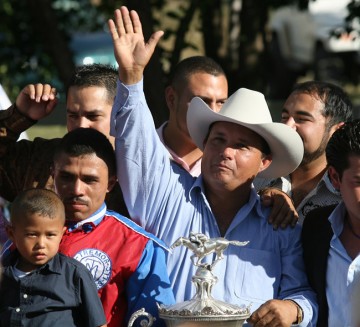Editor’s Note – Cartel money flows across the land as we pointed out earlier by laundering through very large banks, now we see they are using horse racing as well.
Mexican Cartel Hides Millions in Horse Races, U.S. Alleges
By GINGER THOMPSON – NY Times
Newcomers rarely make it into the winner’s circle at the All American Futurity, considered the Kentucky Derby of quarter horse racing.
Yet in September 2010, a beaming band of men waving Mexican flags and miniature piñatas swept into Ruidoso, N.M., to claim the million-dollar prize with a long-shot colt named Mr. Piloto.
Leading the revelry at the track was Mr. Piloto’s owner, José Treviño Morales, 45, a self-described brick mason who had grown up poor in Mexico. Across the border, Ramiro Villarreal, an affable associate who had helped acquire the winning colt, celebrated at a bar with friends.
As for the man who made the whole day possible, Miguel Ángel Treviño Morales, he was living on the run, one of the most wanteddrug traffickers in the world.
Mr. Treviño, a younger brother of José Treviño, is second in command of Mexico’s Zetas drug trafficking organization. Thin with a furrowed brow, he has become the organization’s lead enforcer — infamous for dismembering his victims while they are still alive.
The race was one of many victories for the Treviño brothers, who managed to establish a prominent horse breeding operation in the United States, Tremor Enterprises, that allowed them to launder millions of dollars in drug money, according to current and former federal law enforcement officials. The operation amounted to a foothold in the United States for one of Mexico’s most dangerous criminal networks, the officials said.
Using Miguel Ángel Treviño’s cash, José Treviño’s legal residency and Mr. Villarreal’s eye for a good horse, Tremor bought a sprawling ranch in Oklahoma and an estimated 300 stallions and mares. The Treviño brothers might have kept their operation quiet, given the criminal connection, but their passion for horses and winning apparently proved too tempting. In the short span of three years, Tremor won three of the industry’s biggest races, with prizes totaling some $2.5 million.
The business was “so far out there it’s hard to believe,” said Morris Panner, a former prosecutor who handled drug cases. “Maybe they were using some kind of perverse logic that told them they could hide in plain sight, precisely because people wouldn’t believe it or question it.”
The Justice Department moved against Tremor on Tuesday morning, sending several helicopters and hundreds of law enforcement agents to the company’s stables in Ruidoso and its ranch in Oklahoma. José Treviño and several associates were taken into custody and were charged later in the day, the authorities said.
Miguel Ángel Treviño and another brother, Omar, were also charged. The two remain at large in Mexico. Omar Treviño is also a high-ranking member of the Zetas, and an F.B.I. affidavit filed in United States District Court describes him as participating in the money laundering.
The affidavit said the Zetas funneled about $1 million a month into buying quarter horses in the United States. The authorities were tipped off to Tremor’s activities in January 2010, when the Zetas paid more than $1 million in a single day for two broodmares, the affidavit said.
The New York Times became aware of Tremor’s activities in December 2011 while reporting on the Zetas. The Times learned of the government’s investigation last month and agreed to hold this article until Tuesday morning’s arrests.
The brothers’ activities on either side of the border made for a stark contrast. One week in May began with the authorities pointing fingers at Miguel Ángel Treviño for dumping the bodies of 49 people — without heads, hands or feet — in garbage bags along a busy highway in northern Mexico. The week concluded with José Treviño fielding four Tremor horses in a prestigious race at Los Alamitos Race Course, near Los Angeles.
By then, Mr. Villarreal’s story had come to a fatal, fiery end. Not long after the 2010 victory at Ruidoso, he was detained by the Drug Enforcement Administration and reluctantly agreed to work as an informant. Five months later, his charred remains were found in a burnt-out car on the highway outside Nuevo Laredo.
Read the rest here.
_________________
Mike McIntire contributed reporting. Jack Begg, Alain Delaquérière and Sheelagh McNeill contributed research.

